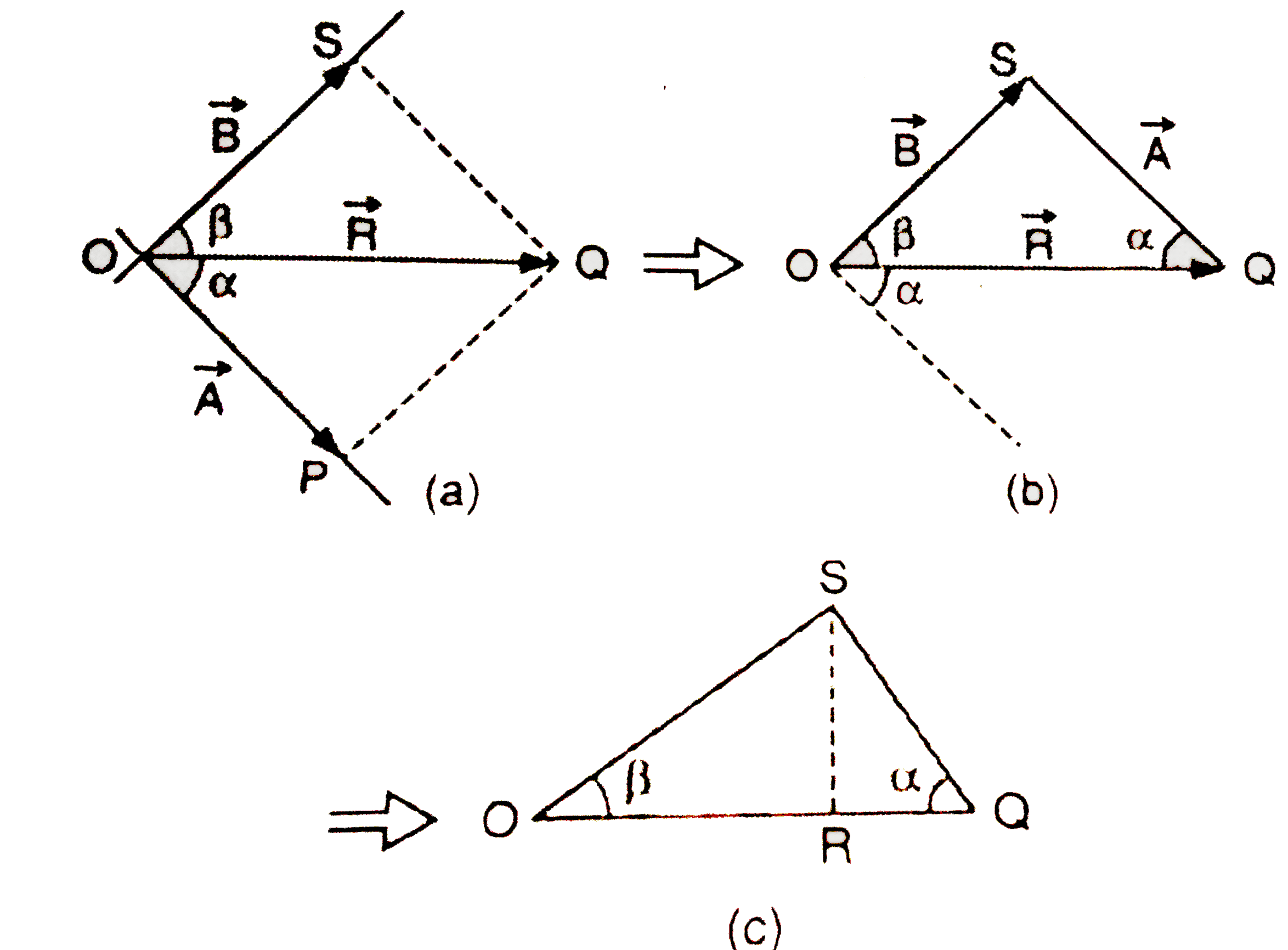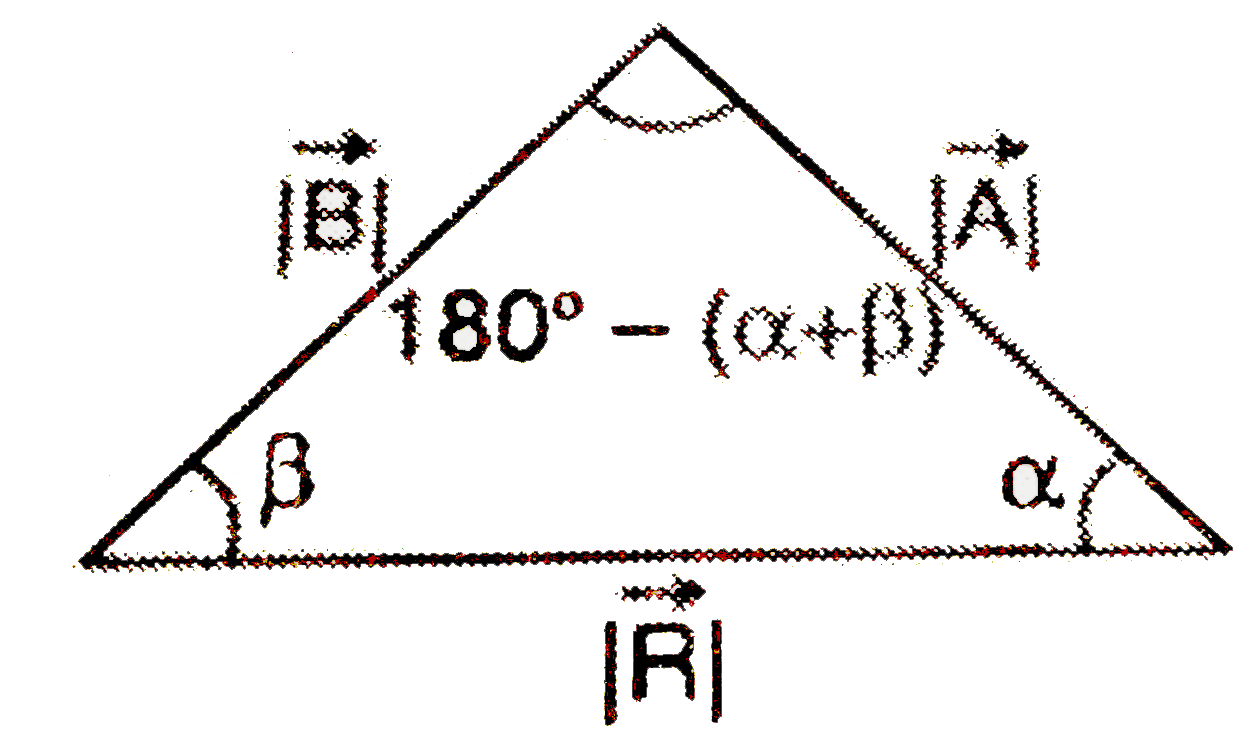Find the components of a vector →R along two straight lines stiuated at both sides of the vector→R making angles α and β with it.
Since the components →Aand→B of the given
vector→R are choose in the given directions, →R is the resultant of
→A and →B, then , →R=→A+→B. Hence, R is repersented by the
diagonal OQ of the square OPQS where the component vectors →A
and →B respresented by the adjacent sides OP and OS
respectivcely according to the parallelogram law of vectors.
Then we convert the parallelorgam OSQP to the vectors triangle
OSQ which represents the vectos →R,→Aand→B as shown in the
Fig. 3.40 (a). By converting to a scalar triangle OSQ as shown in the Fig. 3.40 (c), we can write
OQ=OScosβ+SQcosα ....(i)
and SR=OSsinβ=SQsinα ......(ii)
Solving the Eqs. (i) and (ii), we have
QS=∣∣→A∣∣=OQsinβsin(α+β)=Rsinβsin(α+β)
and OS=∣∣→B∣∣=Rsinαsin(α+β)

Alternate solution
Using Lami,s theorm, we have
∣∣→A∣∣sinβ=∣∣→B∣∣sinα=∣∣→R∣∣sin{180∘−(α−β)}

This yields ∣∣→A∣∣=∣∣→R∣∣sinβsin(α+β)and∣∣→B∣∣=∣∣→R∣∣sinαsin(α+β)
Topper's Solved these Questions
Similar Questions
Find the equation of the straight lines passing through the origin making an angle α with the straight line y=mx+c.
View SolutionSuppose that →p,→qand→r are three non-coplanar vectors in R3. Let the components of a vectors →s along →p,→qand→r be 4, 3 and 5, respectively. If the components of this vector →s along (−→p+→q+→r),(→p−→q+→r)and(−→p−→q+→r) are x,yandz, respectively, then the value of 2x+y+z is
View Solution
Knowledge Check
- Question 1 - Select One
The angle between two vector A and B is θ. Vector R is the resultant of the two vectors. If R makes an angle θ2 with A, then
AA=2BBA=B2CA = BDAB = 1 - Question 2 - Select One
Find the ratio of the magnetic potential due to the magnetic dipole at two equidisatant points.One of them along a line making an angle of 30∘ with the magnetic dipole moment vector of 60∘ with the magnetic diopole vector.
A2:√3B√3:1C3:√3D1/√3:4
Suppose that →p,→qand→r are three non- coplaner in R3 ,Let the components of a vector→s along →p,→qand→r be 4,3, and 5, respectively , if the components this vector →s along (−→p+→q+→r),(→p−→q+→r)and(−→p−→q+→r) are x, y and z , respectively , then the value of 2x+y+z is
View SolutionFind the radius vector defining the position of a point source of spherical waves if that source is known to be located on the straight line between the points with radius vector r1 and r2 at which the oscillation amplitudes of particles of the medium are equal to a1 and a2. The damping of the wave is negligible, the medium is homogeneous.
View SolutionThere vectors →P,→Qand→R are such that →P+→Q+→R=0 Vectors →P and →Q are equal in , magnitude . The magnitude of vector →R is √2 times the magnitude of either →Por→Q . Calculate the angle between these vectors .
View SolutionFind the direction ratios and the direction cosines of the vector →r=ˆi+ˆj+ˆk.
View SolutionThe vector →P=aˆi+βˆi+γˆk,a≠0, lies in the plane of the vector →Q=ˆi+ˆjand→R=ˆi+ˆk and bisects the acute angle between →Qand→R Then the value of 3β+4γ2α is
View SolutionThere are two vectors →A=3ˆi+ˆj and →B=ˆj+2ˆk. For these two vectors-
(a) Find the component of →A along →B in vector form.
(b) If →A&→B are the adjacent sides of a parallalogram then find the magnitude of its area.
(c) Find a unit vector which is perpendicular to both →A&→B.View Solution

